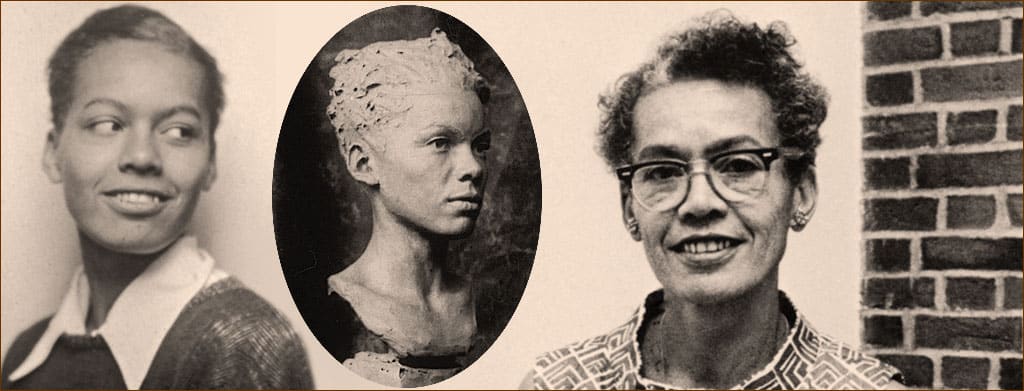
Pauli Murray may be one of the 20th century’s most important historical figures you’ve never heard of. She was a civil rights activist; a gender rights activist and feminist; a lawyer and brilliant legal strategist; historian, author and poet; and, later in life, an ordained priest.
Perhaps she is so little known because she was so far ahead of her time — her work fell through society’s cracks until time caught up to our ability to understand her place in history.
MIXED RACE ORPHAN
Anna Pauline “Pauli” Murray was born into a mixed-race family in Baltimore in 1910, the granddaughter of a slave and great-granddaughter of a slave owner. She was effectively orphaned by age four when her mother suddenly died of a cerebral hemorrhage and her father sent her to be raised by maternal relatives in North Carolina because he could not care for six children, all under the age of ten. Suffering the psychological long-term effects of typhoid fever, William Murray was committed to Maryland’s Crownsville State Hospital (founded in 1911 as the Hospital for the Negro Insane), where a guard beat him to death with a baseball bat when his daughter was 12 years old.
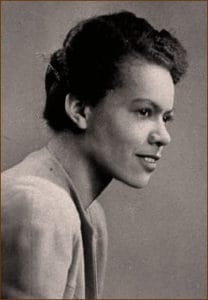
SEGREGATED HIGH SCHOOL
Coming from four generations of teachers, and despite the barriers of poverty, racism and sexism, Murray was determined to advance her education. She graduated high school at the top of her class in 1926, only to learn that her segregated high school had not adequately prepared her for college.
Nevertheless, she persisted, moving to New York City to live with relatives while pursuing the required course work for admission to Hunter College (considered the “poor girls’ Radcliffe”) and, in the process earning a second high-school diploma from Richmond Hills High School in Queens as the only African-American among 4,000 students.
LAW DEGREE
Murray graduated from Hunter with her B.A. in English, only to be denied admission to the graduate program of all-white University of North Carolina at Chapel Hill in 1938 because of her race. Three years later, she entered Howard University Law School, graduating first in her class as its only female. But more rejection followed when she applied to Harvard Law in 1944, her admission denied because of her gender despite a strong recommendation by President Roosevelt, himself a Harvard alumni. She was eventually accepted at the Boalt Hall Law School at UC Berkeley, from which she received her Master of Laws (LLM) degree in 1945.
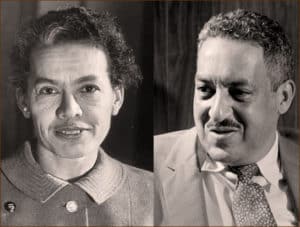
Murray’s persistence paid off and she emerged with a reputation as a brilliant legal strategist. In fact, when Thurgood Marshall was crafting the legal strategy for Brown v. Board of Education in 1954, which desegregated American public schools, he used key points from a paper Murray wrote in her final year at Howard Law School. And when Ruth Bader Ginsburg argued and convinced the Supreme Court that the Equal Protection Clause of the Fourteenth Amendment to the U.S. Constitution applied to women, she used a law-review article written by Pauli Murray, leading Ginsburg to cite Murray as “the shoulders on which she stands.”
[perfectpullquote align=”right” color=”#663300″ size=”20″]”What is often called exceptional ability is nothing more than persistent endeavor.”[/perfectpullquote]Twenty years later, Murray became the first African-American awarded a Doctor of Judicial Science degree — highest academic degree in the legal field — from Yale University Law School, and the namesake of the Pauli Murray College at Yale University which opened in 2017.
NOW CO-FOUNDER
Long the target of so much overt racism and sexism, is it any wonder Pauli Murray became a civil rights and gender rights activist? In 1940, a full 15 years before Rosa Parks and the Montgomery bus boycott, she was arrested in Virginia for refusing to sit on broken seats in the back of a Greyhound bus. Two years later, while at Howard Law, she and fellow activists formed CORE (the Congress of Racial Equality), whose mission was “to bring about equality for all people regardless of race, creed, sex, age, disability, sexual orientation, religion or ethnic background.”
[perfectpullquote align=”right” color=”#663300″ size=”20″]”If one could characterize in a single phrase the contribution of Black women to America, I think it would be ‘survival with dignity against incredible odds’…”[/perfectpullquote]In the early 1960s, President Kennedy tapped Murray for his Commission on the Status of Women. Along with Betty Friedan, Shirley Chisholm and PR executive Muriel Fox, she went on to co-found the National Organization for Women in 1966.
MCCARTHYISM TARGET
But in the early 1950s, like so many activists, Pauli Murray found herself in the crosshairs of Senator Joseph McCarthy’s Select Committee “Red Scare” investigations, costing her a consulting job at Cornell University because prominent people who had provided references for her — Eleanor Roosevelt, Thurgood Marshall and Philip Randolph, who led the Brotherhood of Sleeping Car Porters (the first predominantly black labor union) among them — were considered to be radicals. This was also a time when Murray became the victim of what some have called the “politics of respectability.”
As a black women’s rights activist who identified as a man and was completely open about her relationships with women, Pauli Murray embodied the term “intersectional” long before Professor Kimberlé Crenshaw coined it in 1989.
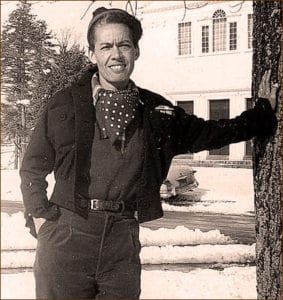
In the 1920s and ’30s, during which unmarried women, African-Americans and the LGBTQ community experienced fierce backlash, Murray rejected the label “homosexual” as incompatible with her goal of achieving respectability. She dressed as a male and, for much of her life, presented as masculine-of-center, changing her birth name to the gender-neutral “Pauli” while at Hunter. She once described herself as “outwardly female, inwardly male,” believing God had intended her to be a man. Today, looking back with 21st-century eyes, we see her lifelong struggle with sexuality as expressions of gender dysphoria and transgender identity.
In 1973, after a life filled with struggles on so many fronts, Murray sought the wisdom of a priest at Boston’s Emmanuel Church about what she felt was a call to ordination; she was 62 years old. According to church records and Murray’s personal notes, her maternal aunts had been prominent “among colored members of the Episcopal Diocese of North Carolina.”
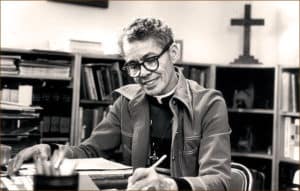
MASTER OF DIVINITY DEGREE
Murray entered the General Theological Seminary in New York City, earning her Master of Divinity degree in 1976. The following year, she became the first African-American woman ordained a priest in the Protestant Episcopal Church. Even after Episcopal Church law forced her into retirement at age 72, she continued to minister to the hospitalized and homebound in Alexandria, Virginia. And, in 2012, more than 25 years after her death, the Rev. Dr. Pauli Murray was named to Holy Women, Holy Men by the 77th General Convention of the Episcopal Church, making her an Episcopal saint.
DEATH
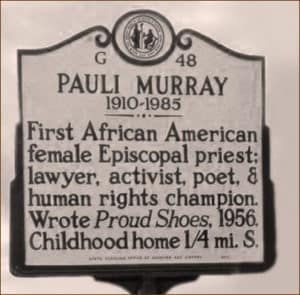
Upon her death, she left 135 boxes of personal papers and photographs to The Schlesinger Library at the Radcliffe Institute for Advanced Study at Harvard University. It was an ironic gift, considering Pauli Murray’s application to Harvard Law’s master’s program some 41 years earlier had been resoundingly rejected with the words, “You are not of the sex entitled to be admitted to Harvard Law School.”

I am an activist for over 50 years and the first time I heard about Precious Pauli Murray I am grateful to have heard her story of her struggles, relations, education, travel are all insermountable. I love you ❤️ Pauli.
Miss Paulina Murray is a very intelligent woman of color. Also was for women’s rights as long as intersexual partners. She didn’t want to be known for being a strong black woman but she left notes. So people would know who she was and learn about her life and her struggles as a biracial woman. I am glad to have known her and read her little story and seen her on channel 7 News. Children raised from Robert Taylor projects one day can become someone just as strong as she was a beacon of Hope for the people of color
Do nice to be reminded of her. I actually first learned about her in a New Yorker article a few years back. I found her stunning then and stunning still.